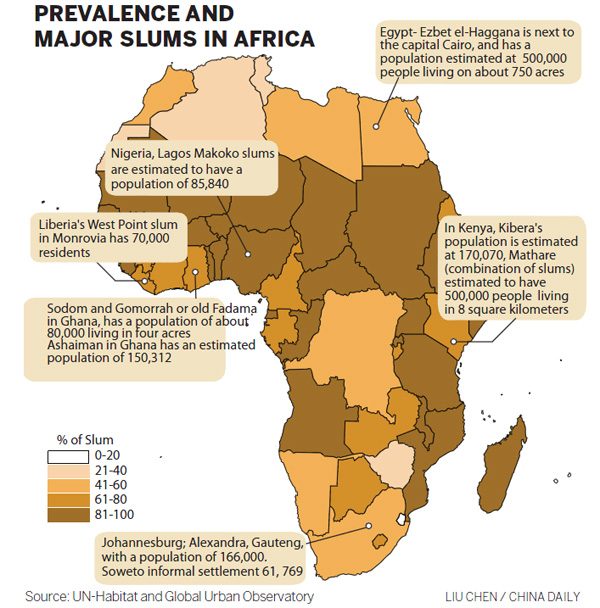Housing homeless has mixed record of success
By China Daily (China Daily Africa) Updated: 2014-11-21 13:22

Many projects aimed at improving the living conditions of those living in slums across Africa have been carried out over the years, meeting with various degrees of success. Those generally regarded as having been successful include:
In Kenya, Huruma, one of many slums in the greater Mathare settlement of the capital, Nairobi. Locals campaigned to buy land they were living in, and, led by a nonprofit organization, pooled their savings and approached the local government to be granted land tenure. They were eventually guaranteed the right to land they had squatted on for more than a decade.
A local micro-financier, Akiba Mashinani Trust, gave them loans that meant they could build about 240 units accommodating a total of more than 1,000 people. Beneficiaries continue to borrow money to expand their businesses so they can afford to repay their loans.
The Amui-Dzor housing project in greater Accra, Ghana, is an effort to make up for failed government-led initiatives that were unresponsive to the needs of the urban poor. Residents of Ashaiman, a municipality where a large proportion of dwellers live roughly, mobilized. They pooled savings, and used the funds to begin dealing with issues affecting them. With the help of a group known as the Ghanaian Urban Poor Federation, they set up the Amui Dzor Housing Cooperative and planned to build a development housing 32 families. In partnership with United Nations-Habitat, the UN human settlement program, they negotiated a long-term mortgage from a commercial bank with interest of 12 percent.
The federation negotiated with local authorities to secure land for the project and formulated a relocation plan to temporarily house those displaced by construction.
Included is a three-story structure consisting of 15 commercial units, one- and two-bedroom apartments and a 12-seater public toilet that is managed by the cooperative with a minimal fee. These funds are used to help repay loans.
The project has been recognized as a model for providing affordable housing. In 2010 a panel of housing experts named Amui Dzor Housing Project the best social innovative housing project for the urban poor and low-income people.
Among the housing projects generally regarded as less successful are:
Kenya Kibera Slum Upgrading program, a collaboration between the government and UN-Habitat, where 900 housing units will be built. After surveying and mapping out the area, dwellers living in Soweto village were relocated to a site where about 600 units housing about 5,000 people were built. The residents considered the rent unaffordable, and many have moved back to the shacks and sub-let the units to middle-income tenants.
Apart from the community disowning the project, a court order has stalled the initiative after a community of Nubian descent claimed ownership of the land. It said that despite living on the land for more than 150 years the government had failed to recognize its rights.
The government planned to sell the completed units to the slum dwellers through their cooperatives. Though the government has tried to improve living conditions, many slum dwellers are said to prefer having better jobs than having upgraded housing. The unemployment rate in the country stands at 40 percent.
The Reception Area, in Windhoek, Namibia. The government created the area to control the influx of people migrating to the city. These were temporary settlements to accommodate people before they secured employment in the city. It was expected that they would eventually move out and acquire fully serviced property elsewhere. Unfortunately, most have not moved from the areas and instead more unplanned settlements have sprung up and expanded significantly in other areas.
The government decision was made without community participation, and most households can barely afford the monthly rent the government charges. The poor payment culture is also attributed to a general perception that the settlement is temporary and insecure.
(China Daily Africa Weekly 11/21/2014 page7)










